The Intel Core i9-7980XE and Core i9-7960X CPU Review Part 1: Workstation
by Ian Cutress on September 25, 2017 3:01 AM ESTBenchmarking Performance: CPU System Tests
Our first set of tests is our general system tests. These set of tests are meant to emulate more about what people usually do on a system, like opening large files or processing small stacks of data. This is a bit different to our office testing, which uses more industry standard benchmarks, and a few of the benchmarks here are relatively new and different.
All of our benchmark results can also be found in our benchmark engine, Bench.
PDF Opening
First up is a self-penned test using a monstrous PDF we once received in advance of attending an event. While the PDF was only a single page, it had so many high-quality layers embedded it was taking north of 15 seconds to open and to gain control on the mid-range notebook I was using at the time. This put it as a great candidate for our 'let's open an obnoxious PDF' test. Here we use Adobe Reader DC, and disable all the update functionality within. The benchmark sets the screen to 1080p, opens the PDF to in fit-to-screen mode, and measures the time from sending the command to open the PDF until it is fully displayed and the user can take control of the software again. The test is repeated ten times, and the average time taken. Results are in milliseconds.
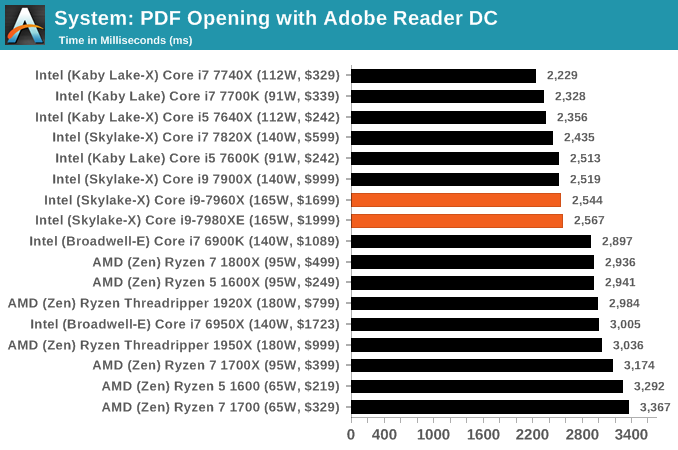
FCAT Processing: link
One of the more interesting workloads that has crossed our desks in recent quarters is FCAT - the tool we use to measure stuttering in gaming due to dropped or runt frames. The FCAT process requires enabling a color-based overlay onto a game, recording the gameplay, and then parsing the video file through the analysis software. The software is mostly single-threaded, however because the video is basically in a raw format, the file size is large and requires moving a lot of data around. For our test, we take a 90-second clip of the Rise of the Tomb Raider benchmark running on a GTX 980 Ti at 1440p, which comes in around 21 GB, and measure the time it takes to process through the visual analysis tool.
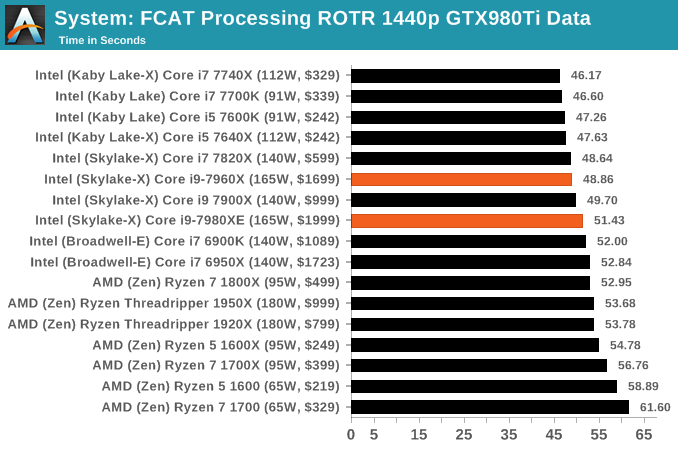
Dolphin Benchmark: link
Many emulators are often bound by single thread CPU performance, and general reports tended to suggest that Haswell provided a significant boost to emulator performance. This benchmark runs a Wii program that ray traces a complex 3D scene inside the Dolphin Wii emulator. Performance on this benchmark is a good proxy of the speed of Dolphin CPU emulation, which is an intensive single core task using most aspects of a CPU. Results are given in minutes, where the Wii itself scores 17.53 minutes.
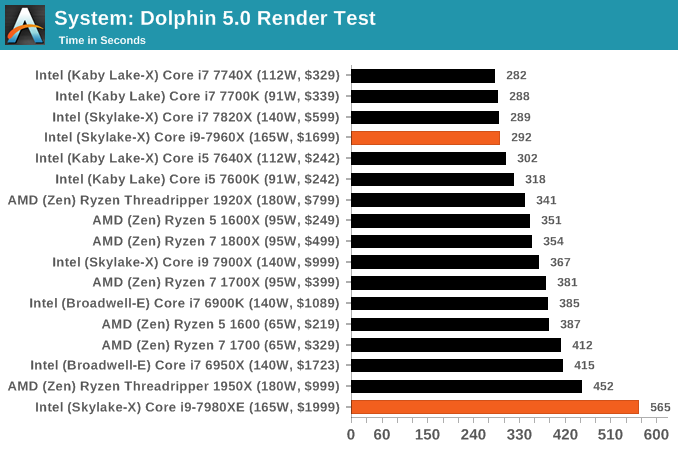
3D Movement Algorithm Test v2.1: link
This is the latest version of the self-penned 3DPM benchmark. The goal of 3DPM is to simulate semi-optimized scientific algorithms taken directly from my doctorate thesis. Version 2.1 improves over 2.0 by passing the main particle structs by reference rather than by value, and decreasing the amount of double->float->double recasts the compiler was adding in. It affords a ~25% speed-up over v2.0, which means new data.
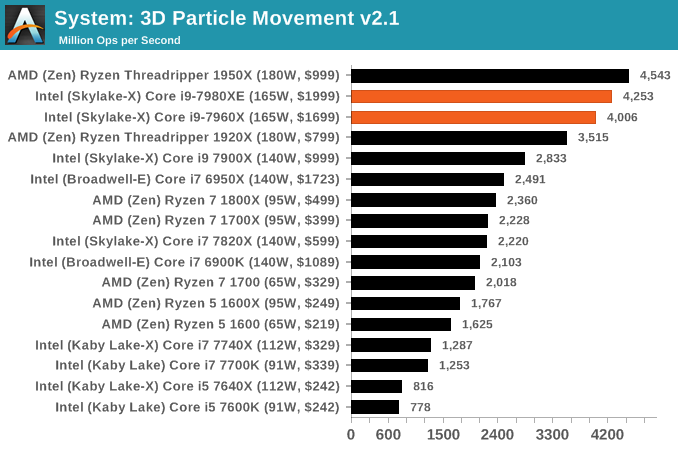
DigiCortex v1.20: link
Despite being a couple of years old, the DigiCortex software is a pet project for the visualization of neuron and synapse activity in the brain. The software comes with a variety of benchmark modes, and we take the small benchmark which runs a 32k neuron/1.8B synapse simulation. The results on the output are given as a fraction of whether the system can simulate in real-time, so anything above a value of one is suitable for real-time work. The benchmark offers a 'no firing synapse' mode, which in essence detects DRAM and bus speed, however we take the firing mode which adds CPU work with every firing.
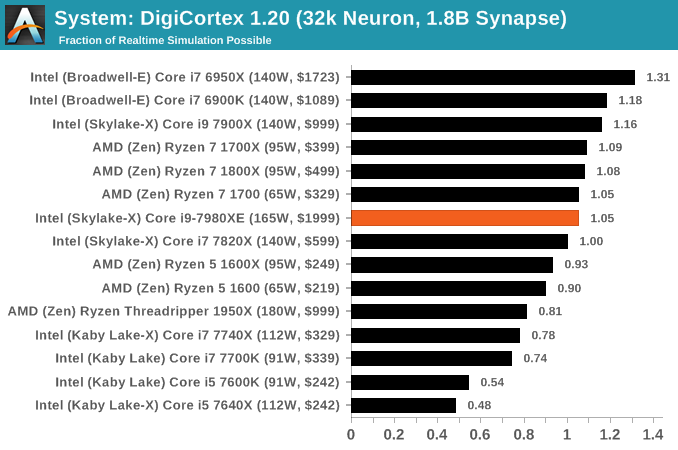
Agisoft Photoscan 1.3.3: link
Photoscan stays in our benchmark suite from the previous version, however now we are running on Windows 10 so features such as Speed Shift on the latest processors come into play. The concept of Photoscan is translating many 2D images into a 3D model - so the more detailed the images, and the more you have, the better the model. The algorithm has four stages, some single threaded and some multi-threaded, along with some cache/memory dependency in there as well. For some of the more variable threaded workload, features such as Speed Shift and XFR will be able to take advantage of CPU stalls or downtime, giving sizeable speedups on newer microarchitectures.
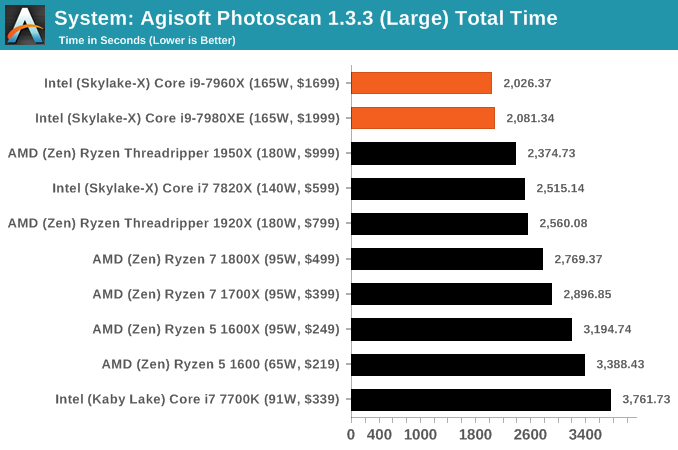










152 Comments
View All Comments
tamalero - Wednesday, September 27, 2017 - link
Hey guys, question.. Toms and others have mentioned that they HAD to put watercooling to keep this thing stable.Did the same happened to your sample? Wouldnt that increase the "cost of ownership" even more than the intel counterpart?
I mean, the mobo, the ram, the watercooling kit and then the hefty processor?
samer1970 - Wednesday, September 27, 2017 - link
Water cooling is for overclocking only ... you will be okay using 170 watt TDP rated air cooler if you dont oc.0ldman79 - Wednesday, September 27, 2017 - link
I'm going to grab another cup-o-coffee and read it again, but the performance per dollar, AMD costs about half as much as Intel for several comparable models, how does Intel have better performance per dollar on so many of those graphs?Admittedly my kids are driving me nuts and I've been reading this for two days now trying to finish...
silvertooth82 - Thursday, September 28, 2017 - link
if this is all true... let's say thanks to AMD for poking IntelAnnonymousCoward - Friday, September 29, 2017 - link
Very nice review. So compared to a 6700K/7700K, the 18-core beast is marginally slower in single-thread, and only 2-3x faster in multi-thread.I found the time difference when opening the big PDF to be the most interesting chart. 65W Ryzens take a noticable extra second.
Exceeding the published TDP sounds like lawsuit territory.
nufear - Monday, October 2, 2017 - link
Price for Intel Core i9-7980XE and Core i9-7960XMy opinion, I can not justify to spend extra $700~1k on these processors. The performances weren't that significant.
rwnrwnn7 - Wednesday, October 4, 2017 - link
AVX-512 - What software work with him?for what it used today?
rwnrwnn7 - Wednesday, October 4, 2017 - link
AVX-512 - What software work with him?for what it used today?
DoDidDont - Friday, October 27, 2017 - link
Would have been nice to see the Xeon Gold 6154 in the test. 18 cores / 36 threads and apparently an all core turbo of 3.7Ghz, plus the advantage of adding a second one on a dual socket Mobo.Planning a pair of 6154's on either an Asus WS C621E or a Supermicro X11DPG-QT and Quad GPU set up.
My 5 year old dual E5-2687w system scores 2298 in Cinebench R15, which has served me well and paid for itself countless times over, but having dual 6154's will bring a huge smile to the face for V-ray production rendering.
My alternative is to build two systems on the i9-7980XE, one for content creation, single CPU, single GPU, and the other as a GPU workhorse for V-ray RT, and Iray, single CPU, Quad GPU+ to call on when needed.
So the comparison would have been nice for the various tests performed.
sharath.naik - Sunday, December 3, 2017 - link
Isn't there supposed to be part 2!!!